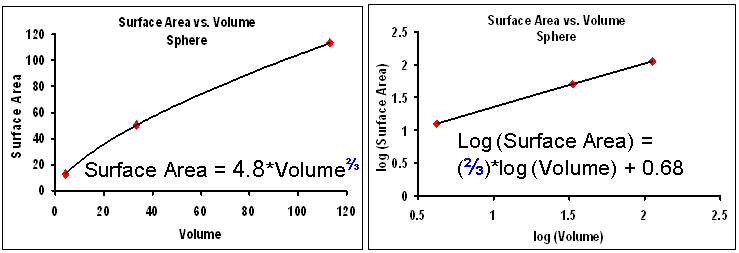Spheres scale at 2/3 also
Wow! It turns out that when you fit the data for this relationship, the value of "a" is different, but the value of "b" has the same value for spheres and cubes: ⅔
Here again are the data for spheres using both the normal power function and the log-transformed function:!
Power function
|
Log-transformed function
|
Y = aXb
|
log(Y) = b*log(X) + log(a)
|

|
|
COOL! Surface area scales to volume to the ⅔ power!
And it turns out, this is true for any shape with a smooth surface. While the value of "a" varies from shape to shape (you can even figure out the value for each geometric shape if you want to!), the value for "b" remains constant at ⅔. This makes sense if you think about it - because surface area and volume are both calculated from a measurement of length, but surface area is always proportional to length squared while volume is always proportional to length cubed. Since we are dividing surface area (calculated from a squared quantity) by volume (calculated from a cubed quanitity) - we always end up with a ⅔ power relationship, no matter the shape.
Now we understand the mathematics behind why people thought that metabolic rate and metabolism would scale with a ⅔ power relationship. They thought it was related to how volume and surface area grew at different rates as organisms got larger. In the next section, you will see what happens when people began measuring the value of "b" - they got an unexpected result - that metabolism scaled with body size with a 3/4 power relationship. And that led to some new theories about what biological processes were limiting metabolic rates.
Copyright University of Maryland, 2007
You may link to this site for educational purposes.
Please do not copy without permission
requests/questions/feedback email: mathbench@umd.edu